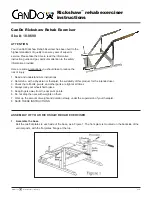
11
Adjustments
–
Changing the Footplate Angle
1.
Locate the footplate angle adjustment plunger
underneath the footplate (Fig 22, Item 1).
2.
Pull and hold the cap of the plunger whilst moving
the footplate to the desired measurement. The
measurement setting is shown on the scale (Fig 23,
Item 1) by the indicator on the frame (Fig 23, Item
2). Setting 1 = 90
°
, Setting 2 = 105° and Setting 3 =
120° from the vertical.
10.
Manual controls
NOTE
: For the electric version of the Configura
Advance chair, refer to section 11.
The manual (non-powered) version of the Configura
Advance chair has the following controls:
1.
Manual Backrest
–
The backrest can be adjusted
between 90 degrees and 130 degrees from the
seat angle; see page 5 for a diagram of this. The
backrest lever (Fig 24, Item 1) is used to adjust this
angle. The backrest is also fitted with a lockout
slide (Fig 24, Item 4.) that can be used to restrict
the use of the backrest angle adjustment.
2.
Manual Tilt-in-Space
–
The tilt-in-space position can
adjust the seat angle from 7 degrees to 37 degrees
from the horizontal position; see page 5 for a
diagram of this. The Tilt-in- space lever (Fig 24, Item
2) is used to adjust this angle.
3.
Manual Forward Tilt
–
The chair can tilt forwards
from 7 degrees normal tilt to 10 degrees of forward
tilt with lock bolts removal.
4.
Manual Leg rest
–
The leg rest can be adjusted
between 75 degrees and 160 degrees; see page 5
for a diagram of this. The Leg rest lever (Fig 24, Item
3) can be used to adjust this angle
.
Manual Backrest Adjustment
1.
Make sure the brakes on all 3 locking castors are
locked on.
2.
Locate the locking lever (Fig 25, Item 2) on the side
of the backrest lockout slide (Fig 25, Item 1).
3.
Release the backrest lockout slide by lifting the
locking lever away from the backrest lockout slide.
The backrest can now be adjusted using the
backrest lever.
Figure 22
1
Figure 23
2
1
WARNING
Check for obstructions around, above and
below the chair frame and position the chair
so that it can operate through the full
adjustment range without any possibility of
obstruction or entrapment.
Always engage the castor brakes when the
chair is stationery or left unattended.
Make sure the castor brakes are in the locked
position before using the manual controls.
Be aware of entrapment risks through opening
and closing gaps as the chair is adjusted.
Ensure the patient is in a stable sitting position
while any of the following adjustments are
made.
3
1
2
4
Figure 24
–
Overview of manual controls










































